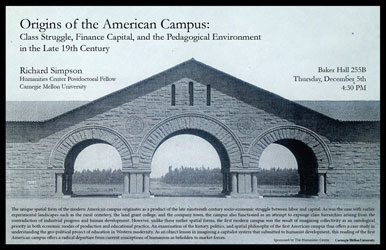Origins of the American Campus

Class Struggle, Finance Capital, and the Pedagogical Environment in the Late 19th Century

The unique spatial form of the modern American campus originates as a product of the late nineteenth century socio-economic struggle between labor and capital. As was the case with earlier experimental landscapes such as the rural cemetery, the land grant college, and the company town, the campus also functioned as an attempt to expunge class hierarchies arising from the contradiction of industrial progress and human development. However, unlike these earlier spatial forms, the first modern campus was the result of imagining collectivity as an ontological priority in both economic modes of production and educational practice. An examination of the history, politics, and spatial philosophy of the first American campus thus offers a case study in understanding the geo-political project of education in Western modernity. As an object lesson in imagining a capitalist system that submitted to humanist development, this reading of the first American campus offers a radical departure from current conceptions of humanism as beholden to market forces.
Richard Simpson was the Humanities Center Postdoctoral Fellow 2013-2014
